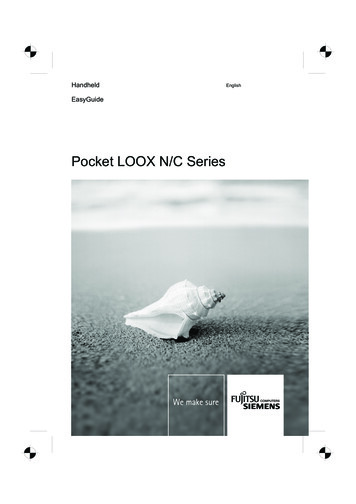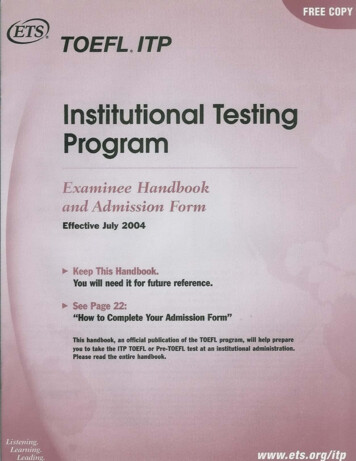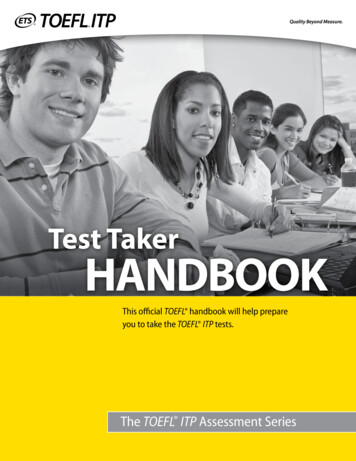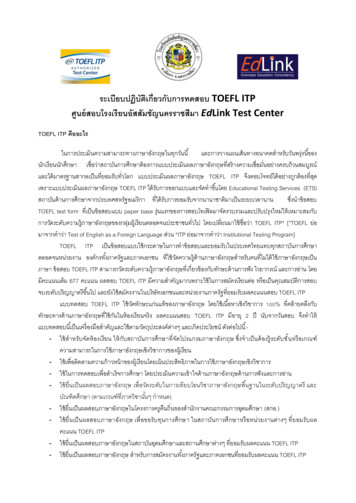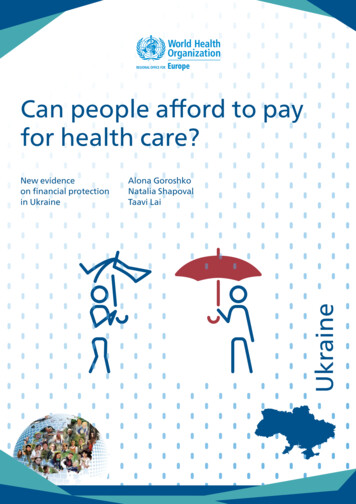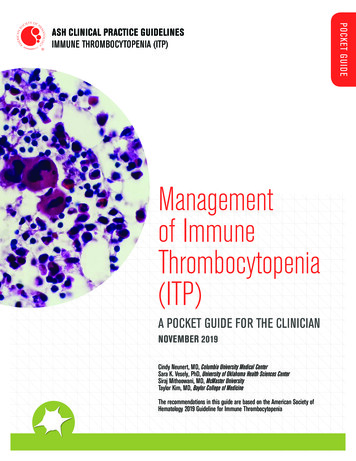
Transcription
Managementof ImmuneThrombocytopenia(ITP)A POCKET GUIDE FOR THE CLINICIANNOVEMBER 2019Cindy Neunert, MD, Columbia University Medical CenterSara K. Vesely, PhD, University of Oklahoma Health Sciences CenterSiraj Mithoowani, MD, McMaster UniversityTaylor Kim, MD, Baylor College of MedicineThe recommendations in this guide are based on the American Society ofHematology 2019 Guideline for Immune ThrombocytopeniaPO CKET G U I D EASH CLINICAL PRACTICE GUIDELINESIMMUNE THROMBOCYTOPENIA (ITP)
ContextTREATMENTImmune Thrombocytopenia (ITP) is an acquired autoimmune disordercharacterized by a low platelet count resulting from platelet destruction andimpaired platelet production. The incidence of ITP is estimated to be 2 to5 per 100,000 persons in the general population and can be an isolatedprimary condition or it may be secondary to other conditions. The informationin this pocket guide is intended to support patients, clinicians, and otherhealth professionals in making evidence-based decisions about first-andsecond-line management of adults and children with ITP.First-Line Therapies for AdultsIn adults with newly diagnosed ITP, the ASH guideline panel recommendsagainst a prolonged course ( 6 weeks) of prednisone in favor of ashort course ( 6 weeks) and suggests either prednisone (0.5 - 2.0mg/kg/day) or dexamethasone (40 mg/day for 4 days) as the type ofcorticosteroid for initial therapy1 . The ASH guideline panel suggestscorticosteroids alone rather than rituximab and corticosteroids for initialtherapy2 .If a high value is placed on rapidity of platelet count response, an initial course of dexamethasone may be preferred over prednisone, given that dexamethasone increases the likelihood of a platelet count response at 7 days.2If high value is placed on possibility for remission over concerns for potential side effects of rituximab, then aninitial course of corticosteroids with rituximab may be preferred.1AdultINPATIENT VS. OUTPATIENT MANAGEMENTTable 1 – Inpatient vs. Outpatient ManagementPlatelet CountStatusGood Practice StatementManagementPlatelet count of 20 x109/l Newly diagnosedand asymptomatic or minormucocutaneous bleeding Established diagnosisInpatientPlatelet count of 20 x109/l Newly diagnosedand asymptomatic or minormucocutaneous bleeding Established diagnosisOutpatient1For patients receiving corticosteroids, the treating physician should ensurethe patient is adequately monitored for potential side effects regardless of theduration or type of corticosteroid selected. This includes close monitoring forhypertension, hyperglycemia, sleep and mood disturbances, gastric irritationor ulcer formation, glaucoma, my opathy and osteoporosis. Given the potentialimpact of corticosteroids on mental health, the treating physician shouldconduct an assessment of health-related quality of life (HRQoL) (depression,fatigue, mental status etc.) while patients are receiving corticosteroids.Outpatient1Outpatient11Patients who are refractory to treatment, those with social concerns, uncertainty about the diagnosis, significantcomorbidities with risk of bleeding, and more significant mucosal bleeding may benefit from admission to the hospital.The need for admission is also variable across the range of platelet counts represented here (0-20 x109/l).Good Practice StatementPatients not admitted to the hospital should receive education and expeditedfollow-up with a hematologist within 24-72 hours.Second-Line Therapies for AdultsIn adults with ITP lasting 3 months who are corticosteroid-dependent orhave no response to corticosteroids, the ASH guideline panel suggeststhe following as potential second-line therapies (see Figure 1): Thrombopoietin receptor agonist (eltrombopag or romiplostim)1 RituximabOBSERVATION VS. TREATMENT Splenectomy2Determining whether a patient with newly diagnosed ITP should beobserved or requires pharmacological treatment depends on the degree ofthrombocytopenia, patient comorbidities, medications, and age – all of whichimpact the risk of bleeding. Management approaches vary based on diseaseduration, access to care, quality-of-life implications, and patient and providerpreferences, among other factors.Table 2 - Observation vs. Treatment (Newly Diagnosed ITP)Platelet count 30 x 109/l andasymptomatic or minor mucocutaneousbleedingManagement with observation1Platelet count 30 x 109/l andasymptomatic or minor mucocutaneousbleedingTreatment with corticosteroids21For patients with a platelet count at the lower end of this threshold, for those with additional comorbid ities, anticoagulant or antiplatelet medications, or upcoming procedures, and for elderly patients ( 60 years old), treatment withcorticosteroids may be appropriate.2This should include consideration of the severity of thrombocytopenia, additional comorbidities, use of anticoagulantor antiplatelet medications, need for upcoming procedures, and age of the patient.Follow the algorithm in Figure 1 to determine the most suitable secondline therapies based on presentation and patient preferences.Individual patient preference may place a higher value on the use of a daily oral medication (eltrom bopag) or onethat requires weekly subcutaneous injections (romiplostim).2If possible, splenectomy should be delayed for at least one year after diagnosis because of the potential forspontaneous remission in the first year.1Good Practice StatementThe treating physician should ensure that patients have appropriateimmunizations prior to splenectomy and that they receive counseling regardingantibiotic prophylaxis following splenectomy. The treating physician should alsoeducate the patient on prompt recognition and management of fever and referto current recommendations on pre- and post-splenectomy care.Each of the these second-line treatments may be effective therapy andthere fore the choice of treatment should be individualized based onduration of ITP, frequency of bleeding episodes requiring hospitalizationor rescue medication, comorbidities, adherence, medical and socialsupport networks, patient values and preferences, cost, and availability.For example, patients who place a high value on achieving a durableresponse may prefer splenectomy or thrombopoi etin receptor agonists(TPO-RAs), patients who value avoidance of long-term medication mayprefer splenectomy or rituximab, and patients who wish to avoid surgerymay prefer a TPO-RA or rituximab. Patient education and shared decisionmaking are encouraged.
Figure 1: Second-Line Therapies for AdultsAdult with ITP 3 monthsDependent on or unresponsiveto corticosteroidsAssess duration of ITP3-12 months12 months Primary treatment options:Rituximab, TPO-RAPrimary treatment options:Rituximab, Splenectomy,TPO-RAAssess patient valuesand preferencesAssess patient valuesPatient places a highvalue on achievingdurable responsePatient places a highvalue on avoidinglong-term medicationTPO-RARituximabFigure 1. Selection of second-line therapy in adults withITP should be individualized based on duration of diseaseand pa tient values and preferences. Other factors that mayinfluence treatment decisions include frequency of bleedingsufficient to require hospitalization or rescue medication,comorbidities, compliance, medical and social supportnetworks, cost, and availability of treatments. Patienteducation and shared deci sion-making is encouraged.Patient characteristicsActionsPatient places a highvalue on achievingdurable responsePatient places a highvalue on avoidinglong-term medicationPatient placesa high value onavoiding surgeryTreatment options:Splenectomy,TPO-RATreatment options:Rituximab,SplenectomyTreatment options:Rituximab, TPO-RAPatientplaces ahighvalue onavoidingsurgeryPatientplaces ahighvalue onavoidinglong-termmedicationPatientplaces ahighvalue onavoidingsurgeryPatientplaces ahighvalue ondurableresponsePatientplaces ahighvalue onachivingdurableresponsePatientplaces ahighvalue ximabSplenectomyTPO-RARituximabTreatment optionsTPO-RA – thrombopoietin receptor agonistAll recommendations in Figure 1 are conditional recommendations
PediatricSecond-Line Therapies for ChildrenINPATIENT VS. OUTPATIENT MANAGEMENTTable 3 – Management of Newly Diagnosed ITPPlatelet CountManagementPlatelet count of 20 x109/l and no or mildbleeding (skin manifestations) onlyOutpatient1Platelet count of 20 x109/l and no or mildbleed ing (skin manifestations) onlyOutpatient11For patients with uncertainty about the diagnosis, those with social concerns, those who live far from thehospital, or those for whom follow-up cannot be guaranteed, admission to the hospital may be preferable.Good Practice StatementPatients not admitted to the hospital should receive education andexpedited follow-up with a hematologist within 24-72 hours.OBSERVATION VS. TREATMENTIn children with newly diagnosed ITP who have no or minor bleeding,the ASH guideline panel recommends observation over bothintravenous immunoglobulin and anti-D immunoglobulin , andsuggests observation over corticosteroids .TREATMENTFirst-Line Therapies for ChildrenIn children with newly diagnosed ITP who have non-life-threateningmucosal bleeding and/or diminished health-related quality of life, theASH guideline panel suggests corticosteroids rather than intravenous immunoglobulin or anti-D immunoglobulin1 . For patients wherecorticosteroids are contra-indicated or otherwise not preferred, theASH guideline panel suggests either intravenous immunoglobulin oranti-D immunoglobulin2 .In children with newly diagnosed ITP who have non-life-threateningmucosal bleeding and/or diminished health related quality of life,the ASH guideline panel recommends against courses ofcorticosteroids longer than 7 days in favor of courses 7 days orshorter , and suggests prednisone (2 - 4 mg/kg/day; maximum, 120mg daily, for 5-7 days) rather than dexamethasone (0.6 mg/kg/day;maximum, 40 mg/kg/day, for 4 days) .This recommendation assumes corticosteroid dosing as outlined in the following paragraph. This recommendation is reserved only for children with non-major mucosal bleeding.2This recommendation is reserved only for children with non-major mucosal bleeding1Good Practice StatementFor patients receiving corticosteroids, the treating physician should ensurethe patient is adequately monitored for potential side effects regardlessof the duration or type of corticosteroid selected. This includes closemonitoring for hypertension, hyperglycemia, sleep and mood disturbances,gastric irritation or ulcer formation, glaucoma, myopathy and osteoporosis.Given the potential impact of corticosteroids on mental health, the treatingphysician should conduct an assessment of health-related quality of life(HRQoL) (depression, fatigue, mental status etc.) while patients arereceiving corticosteroids.In children with ITP lasting 3 months who have non-life-threateningmucosal bleeding and/or diminished health-related quality of lifeand do not respond to first-line treatment, the ASH guideline panelsuggests the following options for second-line therapies presentedin the order they should be pursued :1. Thrombopoietin receptor agonist (eltrombopag or romiplostim)12. Rituximab3. Splenectomy2Individual patient preference may place a higher value on the use of a daily oral medication (eltrom bopag)or one that requires weekly subcutaneous injections (romiplostim). For pediatric patients, eltrombopagdosing should avoid consumption of calcium containing foods such as dairy products by four hours. Thismay limit the ability of some children to take this medication.2If possible, splenectomy should be delayed as long as possible after diagnosis because of the potential forspontaneous remission in the first year.1Good Practice StatementThe treating physician should ensure that patients have appropriateimmunizations prior to splenectomy and that they receive counselingregarding antibiotic prophylaxis following splenectomy. The treatingphysician should also educate the patient on prompt recognition andmanagement of fever and refer to current recommendations on pre- andpost-splenectomy care.Each of the these second-line treatments may be effective therapyand therefore the choice of treatment should be individualized basedon duration of ITP, frequency of bleeding episodes requiring hospitalization or rescue medication, comorbidities, ad herence, medicaland social support networks, patient values and preferences, cost,and availability. Patient education and shared decision-making areencouraged.
Strength of Recommendations and Quality of EvidenceThe methodology for determining the strength of each recommendation and the quality of theevidence supporting the recommendations was adapted from GRADE: an emerging consensus on rating quality of evidence and strength of recommendations. Guyatt GH, et al; GRADEWorking Group. 2008;336(7650):924–926. More details on this specific adaptation of theGRADE process can be found in American Society of Hematology 2019 Guideline for ImmuneThrombocytopenia.1Strength of RecommendationStrong recommendations - Most individuals should follow the recommended course of action. Formal decision aids are not likely to be needed to help individual patients make decisionsconsistent with their values and preferences.Conditional recommendations - Recognize that different choices will be appropriate for individual patients and that you must help each patient arrive at a management decision consistentwith his or her values and preferences. Decision aids may be useful in helping individuals tomake decisions consistent with their individual risks, values and preferences.How to Use This Pocket GuideASH pocket guides are primarily intended to help clinicians make decisions about diag nosticand treatment alternatives. The information included in this guide is not intended to serve orbe construed as a standard of care. Clinicians must make decisions on the basis of the uniqueclinical presentation of an individual patient, ideally though a shared process that considersthe patient’s values and preferences with respect to all options and their possible outcomes.Decisions may be constrained by realities of a specific clinical setting, including but not limitedto institutional policies, time limitations, or unavailability of treatments. ASH pocket guides maynot include all appropriate methods of care for the clinical scenarios described. As scienceadvances and new evidence becomes available, these pocket guides may become obsolete.Following these guide lines cannot guarantee successful outcomes ASH does not warrant orguarantee any products described in these guidelines.The complete 2019 ASH Clinical Practice Guideline for Immune Thrombocytopenia1 includeadditional remarks and contextual information that may affect clinical decision making. To learnmore about these guidelines, visit hematology.org/ITPguidelines.Conflict of interest information for Drs. Neunert, Vesely, Mithoowani, and Kim may be found athematology.org/pocketguidesCOI.Neunert C, Terrell DR, Arnold DM, et al. American Society of Hematology 2019 guideline for immunethrom bocytopenia. Blood Adv. 2019. In press.1This and other ASH pocket guides are also available in the ASH PocketGuides App, available for Android and iOS devices. More infor mationabout this and other ASH pocket guides may be foundat hematology.org/pocketguides. 2019 American Society of HematologyAll rights reserved. No part of this publication may be reproduced, stored in a retrievalsystem, or transmitted in any form or by any means, electronic or mechanical, includingphotocopy, without prior written consent of the American Society of Hematology.American Society of Hematology2021 L Street NW, Suite 900Washington, DC 20036www.hematology.orgFor expert consultation on immune thrombocytopenia and other hematologic questions,submit a request to the ASH Consult a Colleague program atwww.hematology.org/consult (ASH members only).
A POCKET GUIDE FOR THE CLINICIAN NOVEMBER 2019 ASH CLINICAL PRACTICE GUIDELINES IMMUNE THROMBOCYTOPENIA (ITP) POCKET GUIDE Cindy Neunert, MD, Columbia University Medical Center Sara K. Vesely, PhD, University of Oklahoma Health Sciences Center Siraj Mithoowani, MD, McMaster University Taylor Kim, MD, Baylor College of Medicine

